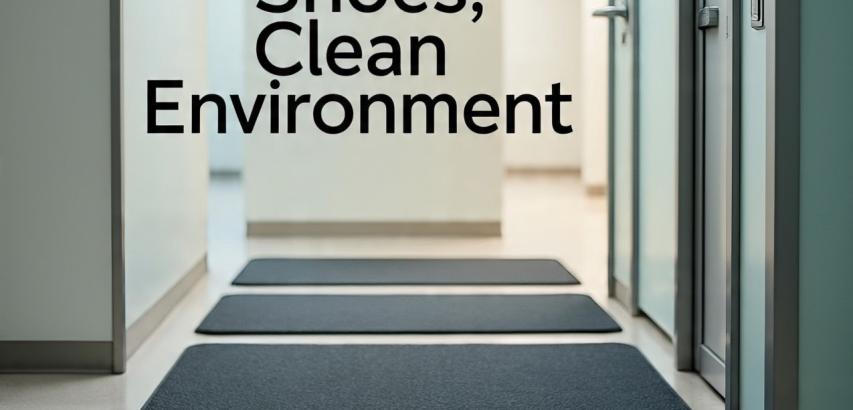Disinfectant shoe mats are specialized flooring solutions designed to reduce the transmission of pathogens (bacteria, viruses, fungi) and contaminants carried on the soles of shoes and boots. They serve as a crucial hygiene barrier, particularly in settings where controlling the spread of germs is critical.
How They Work:
Construction: The mat typically consists of a highly absorbent, durable fabric or foam core housed within a waterproof tray or frame.
Disinfectant Solution: This core is saturated with a liquid disinfectant solution chosen for its effectiveness against target pathogens.
Capillary Action: As a person steps onto the mat, pressure is applied. This pressure forces the disinfectant solution up through the absorbent material via capillary action.
Contact & Disinfection: The solution coats the soles (and sometimes lower sides) of the footwear. The disinfectant chemicals then work to kill or inactivate the microorganisms present on the shoe surface during the brief contact time the person is standing or walking on the mat.
Key Components & Features:
Absorbent Material: Must be resilient to constant foot traffic while effectively wicking and holding the disinfectant. Common materials include specialized foams or dense fibrous mats.
Disinfectant Solution: The choice is critical. It must be:
Effective: Proven to kill the target pathogens (e.g., bacteria like E. coli, Salmonella, viruses like Norovirus, Influenza).
Compatible: Safe for the mat material and the types of flooring it sits on.
Residue: Ideally leaves minimal slippery residue as it dries.
Contact Time: Effective within the typical time footwear spends on the mat.
Tray/Frame: Contains the solution, prevents spills, and protects the underlying floor. Often features a textured or ridged surface to maximize sole contact.
Size & Entry Points: Often placed strategically at key entry/exit points (single doorways, double-door vestibules). Size matters to ensure multiple steps are taken across the mat.
Where They Are Used (Common Applications):
Healthcare Facilities: Hospitals, clinics, labs (especially entrances to isolation wards, ICUs, operating theaters, pharmacies).
Food Processing & Handling: Kitchens, abattoirs, packaging plants (critical for preventing cross-contamination).
Agriculture & Veterinary Settings: Farms, stables, animal hospitals (to control pathogens like Avian Influenza, Foot-and-Mouth).
Cleanrooms & Laboratories: Electronics manufacturing, pharmaceutical production, research labs (maintaining sterile environments).
High-Traffic Public Entrances: During outbreaks or for general hygiene in sensitive buildings.
Residential Use: Homes with infants, immunocompromised individuals, or after dealing with contaminants (e.g., post-flooding, pet illness).
Types:
Passive Mats: Require manual saturation with disinfectant solution. Need regular monitoring and refilling.
Active/Replenishing Systems: Feature integrated reservoirs that automatically keep the mat core saturated, reducing maintenance frequency.
Benefits:
Reduces Pathogen Spread: Proactively kills germs before they are tracked further inside.
Protects Sensitive Environments: Essential for maintaining hygiene standards in critical areas.
Easy to Implement: Relatively simple to install at key entry points.
Cost-Effective Hygiene: Can be a more affordable line of defense compared to some other decontamination methods.
Visible Hygiene Measure: Demonstrates a commitment to cleanliness to staff, visitors, or auditors.
Limitations & Considerations:
Contact Time: Effectiveness relies on shoes having sufficient contact time and pressure on the mat. A quick step reduces efficacy.
Coverage: Primarily disinfects soles; upper parts of shoes and laces may not be treated effectively.
Maintenance: Mats must be kept saturated with fresh disinfectant. Solutions evaporate and become depleted. Regular replacement/refilling is crucial. Dirty mats can become sources of contamination themselves.
Mat Replacement: The absorbent core eventually wears out or becomes clogged and needs replacement.
Disinfectant Choice: Using the wrong disinfectant, or one past its expiry, renders the mat useless. Compatibility with flooring and safety (slipperiness) are vital.
Not a Standalone Solution: Should be part of a broader hygiene protocol including handwashing, surface cleaning, and potentially other PPE.
Disinfectant shoe mats are a valuable, practical tool in infection control and contamination prevention strategies. By targeting the significant vector of contaminated footwear, they provide an important first line of defense at entry points to sensitive environments. Their effectiveness, however, is heavily dependent on proper selection of the mat and disinfectant, consistent maintenance, and realistic expectations about their role within a comprehensive hygiene program. When used correctly, they are a simple yet powerful way to enhance biosecurity and cleanliness.
 |  |  |
Buy Disinfectant Shoe Mat - Amazon
 |  |  |
